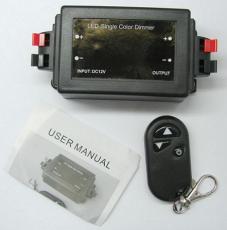Search
Login
Dimmer - how to choose and connect with your own hands
The rapid pace of development of electronic technology fill our home with a variety of devices. One of such comfortable appliances is a dimmer. You can connect a dimmer in a country house yourself. Want to know how?
Content
- What is a dimmer
- Types and general scheme of connecting a dimmer
- Type of construction of the dimmer and its connection video
- Types of execution of dimmers
- LED and touch dimmers video
What is a dimmer
Dimmer (dimmer) is a load power regulator and is used everywhere to adjust the intensity of the glow of various types of lighting devices.
The first dimmers had a purely mechanical control method. Therefore, the dimmer switch could perform the function of changing the brightness of the light fixture. Modern devices with integrated microcontroller regulators have significantly expanded the range of functions performed. There are opportunities to carry out the following functions:
brightness and intensity control
automatic on and off with infinitely adjustable
simulate the effect of presence
various modes of temporary blinking or dimming
remote control over public channels of signal transmission.

Types and general scheme of connecting a dimmer
There are two types of dimmers: mechanical and electronic. The electronic dimmer functions are based on the time characteristics of the main constituent elements. Traditionally, mechanical and electronic dimmers are designed to connect an incandescent or halogen lamp as a load.
In modern electronic dimmers, the elemental base is a transistor and a seven-core key. The general scheme for connecting a dimmer is quite simple, so connecting a device with your own hands in a country house is not difficult.

There is only one connection requirement that is imposed by the dimmer manufacturer. This is a strict observance of the polarity of the connection. The supply wire must be connected to the terminal strip marked L, the wire going to the load in the remaining terminal block connector.
For owners of country houses, the dimmer always causes increased interest. The use of dimmers can significantly save energy in case of forgetfulness of residents or their temporary absence.
Therefore, how to choose and connect a dimmer with your own hands will depend on your preference and expected loads. To adjust the brightness and intensity of light using traditional incandescent, halogen, as well as fluorescent lamps and LEDs.
First you need to decide on the expected functions of the dimmer and select the type of design.
Type of construction of the dimmer and its connection
By their design, dimmers are divided into:
modular
monoblock
mounted
The modular dimmer in appearance resembles a circuit breaker. It is possible to use with incandescent and halogen lamps. Wiring is carried out in switchboards, and control is carried out by a button or key switch.

The monoblock dimmer has a separate compact unit. Therefore, installation involves an installation socket of the appropriate size for the instrument box. The monoblock dimmer is convenient for use in thin partitions, where there is practically no possibility of installing a standard switch.

The built-in dimmers are installed in a standard mounting box. They are used everywhere, thanks to a wide range of applications, ranging from ordinary bulbs to halogen lamps with inductive or capacitive loads.

For any type of dimmer, there is a need for a minimum load (this is approximately 40W). This problem is solved by installing an additional load in parallel with a low-power incandescent lamp.
Do-it-yourself installation and connection of the dimmer is presented in the video.
The design of the dimmer blocks is constantly being improved and provide consumers with new designs.
Types of execution of dimmers
According to their technological design, dimmers are distinguished by:
rotary push
rotary
keyboards
sensory
Rotary dimmer (rheostatic) is designed to adjust the power of the active load in country houses:
simple incandescent and halogen lamps
as well as for:
TENOV and heaters
electric tiles.
The rotary dimmer is controlled by smoothly changing the position of the handle. The power level is adjustable from an off state of 0% to a maximum power of 10%.
Key dimmers are similar to ordinary switches: when you press a key, it turns on or off, and when you hold a plus or minus key in an active state for more than 3 seconds. there is the possibility of direct adjustment.

LED and touch dimmers
From the point of view of efficiency and functionality, the most promising in modern lighting technology are LED and touch dimmers.
LED dimmer designed to adjust the light intensity in LED strips and rulers.
There are management methods:
mechanical, based on the use of a traditional potentiometer
electronic, control is carried out using a touch ring
remote, control occurs from the remote control.
The only significant limitation when connecting an LED dimmer is that it is designed for a certain length of LED strip.
Creative sensory dimmers enjoy the respect of the owners of country houses.
Touch dimmers perfectly combine the functions of a dimmer and a switch. An effective external panel of a touch dimmer with backlight creates respectability and originality in the interior.
Convenience, ease of connection and full compatibility with all existing types of dimmable lamps gives a complete basis for a bright future for this type of dimmer.
How to connect a dimmer for LEDs with touch control, shown in the proposed video.





